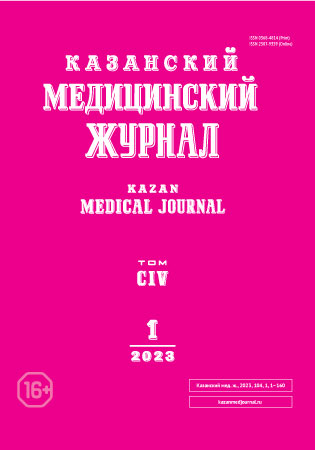Экспрессия микроРНК-590 у пациентов с хронической ишемической болезнью сердца, фибрилляцией предсердий, а также их сочетанием
- Авторы: Лернер Д.Д.1, Маянская С.Д.1, Кравцова О.А.2, Тамбовцева Р.С.2
-
Учреждения:
- Казанский государственный медицинский университет
- Казанский (Приволжский) федеральный университет, Институт фундаментальной медицины и биологии
- Выпуск: Том 104, № 1 (2023)
- Страницы: 30-37
- Раздел: Теоретическая и клиническая медицина
- Статья получена: 26.12.2021
- Статья одобрена: 16.01.2023
- Статья опубликована: 01.02.2023
- URL: https://kazanmedjournal.ru/kazanmedj/article/view/91124
- DOI: https://doi.org/10.17816/KMJ91124
- ID: 91124
Цитировать
Аннотация
Актуальность. Роль микроРНК в процессах ремоделирования, пролиферации и фиброгенеза миокардиоцитов недостаточно ясна.
Цель. Анализ уровня экспрессии микроРНК-590 у пациентов с хронической ишемической болезнью сердца, фибрилляцией предсердий, а также их сочетанием для оценки потенциальной прогностической значимости уровня экспрессии.
Материал и методы исследования. В исследование были включены 94 пациента, разделённых на три клинических группы: первая — с неклапанной фибрилляцией предсердий без ишемической болезни сердца (39 человек); вторая — с неклапанной фибрилляцией предсердий и ишемической болезнью сердца (22 пациента); третья — с ишемической болезнью сердца без фибрилляции предсердий (23 пациента). Группа сравнения — 10 человек без фибрилляции предсердий и ишемической болезни сердца. У всех исследуемых забирали венозную кровь, из плазмы которой выделяли микроРНК. Относительный уровень экспрессии микроРНК оценивали на основании данных полимеразной цепной реакции в реальном времени, полученных в ходе реакции на амплификаторе с использованием коммерческих TaqMan-зондов и праймеров. Статистическую значимость различий между группами определяли с использованием однофакторного дисперсионного анализа, с последующим post-hoc анализом с помощью контрастов Тьюки, различия считали статистически значимыми при р <0,05. Для оценки нормальности распределения остатков использован тест Шапиро–Уилка.
Результаты. Статистически значимое снижение уровня экспрессии микроРНК-590 зарегистрировано в третьей группе (p=0,0104) и во второй (p=0,0046) по сравнению с группой контроля, а также у пациентов с фибрилляцией предсердий и дилатацией левого предсердия (p=0,0313), с рецидивами нарушения ритма после радиочастотной абляции (p=0,0083) и при постоянной форме фибрилляции предсердий (p=0,0242).
Вывод. Ишемическая болезнь сердца, в том числе и при сочетании с фибрилляцией предсердий, и отягощающие факторы, такие как дилатация левого предсердия, постоянная форма фибрилляции предсердий, рецидивы нарушения ритма после радиочастотной абляции, приводят к снижению уровня экспрессии микроРНК-590.
Полный текст
Об авторах
Дина Даулетовна Лернер
Казанский государственный медицинский университет
Автор, ответственный за переписку.
Email: dinakaz84med@mail.ru
ORCID iD: 0000-0002-2123-7141
аспирант, каф. госпитальной терапии
Россия, г. Казань, РоссияСветлана Дмитриевна Маянская
Казанский государственный медицинский университет
Email: Smayanskaya@mail.ru
ORCID iD: 0000-0001-6701-5395
докт. мед. наук, проф., каф. госпитальной терапии
Россия, г. Казань, РоссияОльга Александровна Кравцова
Казанский (Приволжский) федеральный университет, Институт фундаментальной медицины и биологии
Email: okravz@yandex.ru
ORCID iD: 0000-0002-4227-008X
канд. биол. наук, доц., каф. биохимии, биотехнологии и фармакологии
Россия, г. Казань, РоссияРегина Сергеевна Тамбовцева
Казанский (Приволжский) федеральный университет, Институт фундаментальной медицины и биологии
Email: rustyamova.regina@mail.ru
ORCID iD: 0000-0002-0603-8849
мл. научн. сотр., Институт фундаментальной медицины и биологии, Научно-клинический центр прецинзионной и регенеративной медицины, Open Lab генные и клеточные технологии
Россия, г. Казань, РоссияСписок литературы
- Wang F, Zhang H, Wang C. Mir-590-3p regulates cardiomyocyte P19CL6 proliferation, apoptosis and differentiation in vitro by targeting PTPN1 via JNK/STAT/Nf kB pathway. Int J Exp Pathol. 2020;101:196–202. doi: 10.1111/iep.12377.
- Eulalio A, Mano M, Dal Ferro M, Zentilin L, Sinagra G, Zacchigna S, Giacca M. Functional screening identifies miRNAs inducing cardiac regeneration. Nature. 2012;492(7429):376–381. doi: 10.1038/nature11739.
- Takahashi K, Yamanaka S. Induction of pluripotent stem cells from mouse embryonic and adult fibroblast cultures by defined factors. Cell. 2006;126(4):663–676. doi: 10.1016/j.cell.2006.07.024.
- Djuric U, Ellis J. Epigenetics of induced pluripotency, the seven-headed dragon. Stem Cell Res Ther. 2010;1(1):3. doi: 10.1186/scrt3.
- Al-Hasani K, Mathiyalagan P, El-Osta A. Epigenetics, cardiovascular disease, and cellular reprogramming. J Mol Cell Cardiol. 2019;128:129–133. doi: 10.1016/j.yjmcc.2019.01.019.
- Gilsbach R, Schwaderer M, Preissl S, Grüning BA, Kranzhöfer D, Schneider P, Nührenberg TG, Mulero-Navarro S, Weichenhan D, Braun C, Dreßen M, Jacobs AR, Lahm H, Doenst T, Backofen R, Krane M, Gelb BD, Hein L. Distinct epigenetic programs regulate cardiac myocyte development and disease in the human heart in vivo. Nat Commun. 2018;9(1):391. doi: 10.1038/s41467-017-02762-z.
- Lozano-Velasco E, Franco D, Aranega A, Daimi H. Genetics and epigenetics of atrial fibrillation. Int J Mol Sci. 2020;21(16):5717. doi: 10.3390/ijms21165717.
- Livak KJ, Schmittgen TD. Analysis of relative gene expression data using real-time quantitative PCR and the 2(-Delta Delta C(T)) method. Methods. 2001;25(4):402–408. doi: 10.1006/meth.2001.1262.
- Li Y-D, Hong Y-F, Yusufuaji Y, Tang B, Zhou X, Xu G-J, Li J-X, Sun L, Zhang J-H, Xin Q, Xiong J, Ji Y, Zhang Y. Altered expression of hyperpolarization-activated cyclic nucleotide-gated channels and microRNA-1 and -133 in patients with age-associated atrial fibrillation. Mol Med Rep. 2015;12:3243–3248. doi: 10.3892/mmr.2015.3831.
- Della-Fazia MA, Castelli M, Piobbico D, Pieroni S, Servillo G. The Ins and Outs of HOPS/TMUB1 in biology and pathology. Febs J. 2021;288(9):2773–2783. doi: 10.1111/febs.15539.
- Fichtlscherer S, De Rosa S, Fox H, Schwietz T, Fischer A, Liebetrau C, Weber M, Hamm CW, Roxe T, Muller-Ardogan M, Bonauer A, Zeiher AM, Dimmeler S. Circulating microRNAs in patients with coronary artery disease. Circ Res. 2010;107(5):677–684. doi: 10.1161/CIRCRESAHA.109.215566.
- Ahlin F, Arfvidsson J, Vargas KG, Stojkovic S, Huber K, Wojta J. MicroRNAs as circulating biomarkers in acute coronary syndromes: A review. Vascul Pharmacol. 2016;81:15–21. doi: 10.1016/j.vph.2016.04.001.
- Piccoli MT, Gupta SK, Thum T. Noncoding RNAs as regulators of cardiomyocyte proliferation and death. J Mol Cell Cardiol. 2015;89(Pt A):59–67. doi: 10.1016/j.yjmcc.2015.02.002.
- He PP, OuYang XP, Li Y, Lv YC, Wang ZB, Yao F, Xie W, Tan YL, Li L, Zhang M, Lan G, Gong D, Cheng HP, Zhong HJ, Liu D, Huang C, Li ZX, Zheng XL, Yin WD, Tang CK. MicroRNA-590 inhibits lipoprotein lipase expression and prevents atherosclerosis in apoE knockout mice. PLoS One. 2015;10(9):e0138788. doi: 10.1371/journal.pone.0138788.
- Shan H, Zhang Y, Lu Y, Zhang Y, Pan Z, Cai B, Wang N, Li X, Feng T, Hong Y, Yang B. Downregulation of miR-133 and miR-590 contributes to nicotine-induced atrial remodelling in canines. Cardiovasc Res. 2009;83(3):465–472. doi: 10.1093/cvr/cvp130.
Дополнительные файлы






